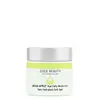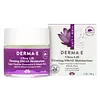What's inside
What's inside
 Key Ingredients
Key Ingredients

 Benefits
Benefits

 Concerns
Concerns

 Ingredients Side-by-side
Ingredients Side-by-side

Aloe Barbadensis Leaf Juice
Skin ConditioningCaprylic/Capric Triglyceride
MaskingGlyceryl Stearate
EmollientHelianthus Annuus Seed Oil
EmollientGlycerin
HumectantStearyl Alcohol
EmollientCetyl Alcohol
EmollientMyristyl Myristate
EmollientGlyceryl Stearate Citrate
EmollientSimmondsia Chinensis Seed Oil
EmollientSqualane
EmollientCaprylyl Glycol
EmollientPyrus Malus Juice
Skin ConditioningVitis Vinifera Juice
AntioxidantCitrus Limon Juice
Skin ConditioningButyrospermum Parkii Butter
Skin ConditioningCarthamus Tinctorius Seed Oil
MaskingPalmitoyl Tripeptide-5
Skin ConditioningBorago Officinalis Seed Oil
EmollientCamellia Sinensis Leaf Extract
AntimicrobialMagnesium Ascorbyl Phosphate
AntioxidantXanthan Gum
EmulsifyingAlgae Extract
EmollientPersea Gratissima Oil
Skin ConditioningUbiquinone
AntioxidantOenothera Biennis Oil
EmollientAllantoin
Skin ConditioningSalix Alba Bark Extract
AstringentPanthenol
Skin ConditioningLinum Usitatissimum Seed Oil
PerfumingHyaluronic Acid
HumectantLonicera Caprifolium Extract
AstringentLonicera Japonica Callus Extract
Skin ProtectingSaccharum Officinarum Extract
MoisturisingThioctic Acid
AntioxidantTocopherol
AntioxidantCitrus Aurantium Dulcis Oil
MaskingCinnamomum Camphora Bark Oil
MaskingLitsea Cubeba Fruit Oil
MaskingEthyl Linalool
MaskingCitral
PerfumingLimonene
PerfumingGeraniol
PerfumingAloe Barbadensis Leaf Juice, Caprylic/Capric Triglyceride, Glyceryl Stearate, Helianthus Annuus Seed Oil, Glycerin, Stearyl Alcohol, Cetyl Alcohol, Myristyl Myristate, Glyceryl Stearate Citrate, Simmondsia Chinensis Seed Oil, Squalane, Caprylyl Glycol, Pyrus Malus Juice, Vitis Vinifera Juice, Citrus Limon Juice, Butyrospermum Parkii Butter, Carthamus Tinctorius Seed Oil, Palmitoyl Tripeptide-5, Borago Officinalis Seed Oil, Camellia Sinensis Leaf Extract, Magnesium Ascorbyl Phosphate, Xanthan Gum, Algae Extract, Persea Gratissima Oil, Ubiquinone, Oenothera Biennis Oil, Allantoin, Salix Alba Bark Extract, Panthenol, Linum Usitatissimum Seed Oil, Hyaluronic Acid, Lonicera Caprifolium Extract, Lonicera Japonica Callus Extract, Saccharum Officinarum Extract, Thioctic Acid, Tocopherol, Citrus Aurantium Dulcis Oil, Cinnamomum Camphora Bark Oil, Litsea Cubeba Fruit Oil, Ethyl Linalool, Citral, Limonene, Geraniol
Water
Skin ConditioningGlycerin
HumectantCaprylic/Capric Triglyceride
MaskingStearyl Alcohol
EmollientCetyl Alcohol
EmollientStearic Acid
CleansingGlyceryl Stearate Citrate
EmollientGlyceryl Stearate
EmollientPolysorbate 20
EmulsifyingDimethyl Mea
BufferingResveratrol
AntioxidantTerminalia Ferdinandiana Fruit Extract
AntioxidantCaffeine
Skin ConditioningCopper PCA
HumectantCeramide Ng
Skin ConditioningUbiquinone
AntioxidantRetinol
Skin ConditioningSodium Hyaluronate
HumectantSimmondsia Chinensis Seed Oil
EmollientThioctic Acid
AntioxidantLavandula Angustifolia Oil
MaskingTetrahexyldecyl Ascorbate
AntioxidantAllantoin
Skin ConditioningTocopheryl Acetate
AntioxidantPanthenol
Skin ConditioningDimethicone
EmollientSodium Hydroxide
BufferingPotassium Sorbate
PreservativeEthylhexylglycerin
Skin ConditioningPhenoxyethanol
PreservativeWater, Glycerin, Caprylic/Capric Triglyceride, Stearyl Alcohol, Cetyl Alcohol, Stearic Acid, Glyceryl Stearate Citrate, Glyceryl Stearate, Polysorbate 20, Dimethyl Mea, Resveratrol, Terminalia Ferdinandiana Fruit Extract, Caffeine, Copper PCA, Ceramide Ng, Ubiquinone, Retinol, Sodium Hyaluronate, Simmondsia Chinensis Seed Oil, Thioctic Acid, Lavandula Angustifolia Oil, Tetrahexyldecyl Ascorbate, Allantoin, Tocopheryl Acetate, Panthenol, Dimethicone, Sodium Hydroxide, Potassium Sorbate, Ethylhexylglycerin, Phenoxyethanol
Ingredients Explained
These ingredients are found in both products.
Ingredients higher up in an ingredient list are typically present in a larger amount.
Allantoin is a soothing ingredient known for its protective and moisturizingg properties. Because of this, it is often added to products with strong active ingredients.
Studies show higher concentrations of this ingredient can promote wound healing.
Though it can be derived from the comfrey plant, allantoin is produced synthetically for cosmetic products to ensure purity.
Learn more about AllantoinThis ingredient is an emollient, solvent, and texture enhancer. It is considered a skin-softener by helping the skin prevent moisture loss.
It helps thicken a product's formula and makes it easier to spread by dissolving clumping compounds.
Caprylic Triglyceride is made by combining glycerin with coconut oil, forming a clear liquid.
While there is an assumption Caprylic Triglyceride can clog pores due to it being derived from coconut oil, there is no research supporting this.
Learn more about Caprylic/Capric TriglycerideCetyl Alcohol is a fatty alcohol. Fatty Alcohols are most often used as an emollient or to thicken a product.
Its main roles are:
Though it has "alcohol" in the name, it is not related to denatured alcohol or ethyl alcohol.
The FDA allows products labeled "alcohol-free" to have fatty alcohols.
Learn more about Cetyl AlcoholGlycerin is already naturally found in your skin. It helps moisturize and protect your skin.
A study from 2016 found glycerin to be more effective as a humectant than AHAs and hyaluronic acid.
As a humectant, it helps the skin stay hydrated by pulling moisture to your skin. The low molecular weight of glycerin allows it to pull moisture into the deeper layers of your skin.
Hydrated skin improves your skin barrier; Your skin barrier helps protect against irritants and bacteria.
Glycerin has also been found to have antimicrobial and antiviral properties. Due to these properties, glycerin is often used in wound and burn treatments.
In cosmetics, glycerin is usually derived from plants such as soybean or palm. However, it can also be sourced from animals, such as tallow or animal fat.
This ingredient is organic, colorless, odorless, and non-toxic.
Glycerin is the name for this ingredient in American English. British English uses Glycerol/Glycerine.
Learn more about GlycerinGlyceryl Stearate is a mix of glycerin and stearic acid.
It is used to stabilize the mixing of water and oil ingredients. By preventing these ingredients from separating, it can help elongate shelf life. It can also help thicken the product's texture.
As an emollient, it helps soften skin and supports barrier-replenishing ingredients.
In cosmetics, Glyceryl Stearate is often made from vegetable oils or synthetically produced.
This ingredient may not be fungal-acne safe
Fun fact: The human body also creates Glyceryl Stearate naturally.
Learn more about Glyceryl StearateGlyceryl Stearate Citrate is a citric acid ester of glyceryl stearate.
It is an emulsifier, emollient, and a surfactant.
Emulsifiers help stabilize a product. It does this by preventing certain ingredients from separating. Common ingredients include oils and water, which do not mix naturally. Emulsifiers have properties that help keep ingredients such as these together.
Emollients help soothe and soften the skin. They do this by creating a protective film on your skin. This barrier helps trap moisture and keeps your skin hydrated. Emollients may be effective at treating dry or itchy skin.
Surfactants help gather oils, dirt, and other pollutants from the skin. This helps them to be easily rinsed away.
Learn more about Glyceryl Stearate CitratePanthenol is a common ingredient that helps hydrate and soothe the skin. It is found naturally in our skin and hair.
There are two forms of panthenol: D and L.
D-panthenol is also known as dexpanthenol. Most cosmetics use dexpanthenol or a mixture of D and L-panthenol.
Panthenol is famous due to its ability to go deeper into the skin's layers. Using this ingredient has numerous pros (and no cons):
Like hyaluronic acid, panthenol is a humectant. Humectants are able to bind and hold large amounts of water to keep skin hydrated.
This ingredient works well for wound healing. It works by increasing tissue in the wound and helps close open wounds.
Once oxidized, panthenol converts to pantothenic acid. Panthothenic acid is found in all living cells.
This ingredient is also referred to as pro-vitamin B5.
Learn more about PanthenolThis oil comes from the seeds of the desert shrub called Jojoba. It is more commonly known as jojoba oil, a non-comedogenic oil.
Jojoba oil does not contain fragrance and has many fatty-acids, making it a great soothing ingredient.
It also contains Vitamin E, a great moisturizing ingredient. Vitamin E is also an antioxidant and protects your skin against oxidative damage.
This ingredient humectant properties, meaning it helps draw moisture from the air. This helps keep your skin hydrated.
While jojoba has antibacterial properties, it is only able to kill some strains of bacteria.
Studies also show it helps in wound healing. In fact, Indigenous cultures have used jojoba as a moisturizer and to help treat burns for centuries.
Fun fact: Jojoba oil similar to natural human skin sebum, so it has a great effect on dry skin. It is also promising with helping to regulate sebum production.
Due to its fatty acid content, Jojoba oil may not be fungal acne safe. We recommend speaking with a professional if you have any concerns.
Learn more about Simmondsia Chinensis Seed OilStearyl Alcohol is a type of fatty alcohol from stearic acid. It is a white, waxy compound used to emulsify ingredients.
Fatty Alcohols are most often used as an emollient or to thicken a product. Emollients help soothe and hydrate the skin by trapping moisture.
They are usually derived from natural fats and oils and therefore do not have the same drying or irritating effect as solvent alcohols. FDA allows products labeled "alcohol-free" to have fatty alcohols.
Learn more about Stearyl AlcoholThioctic Acid is an enzyme and antioxidant. A more common name for this is Alpha Lipoic Acid.
Alpha Lipoic Acid can be naturally found in the mitochondria of every cell.
Antioxidants help fight free-radicals. Free-radicals are molecules that may damage your skin cells. The antioxidants in Alpha Lipoic Acid have been shown to fight damage from cigarette smoke.
Studies also show Alpha Lipoic Acid plays a role in wound healing.
Thioctic Acid will break down when exposed to sunlight.
Many foods contain thioctic acid, including tomato, brussel sprouts, spinach, and broccoli.
Learn more about Thioctic AcidUbiquinone (Coenzyme Q10) is a molecule already found in our bodies. It is a potent antioxidant and skin-soothing ingredient.
Aging and environmental exposure diminishes our skin's natural ubiquinone levels. This is much like our natural collagen and elastin.
The good news is: studies show applying this ingredient topically replenishes ubiquinone levels in our skin. This also comes with a ton of skin benefits. These benefits include:
Ubiquinone is considered a large molecule and cannot be absorbed into the lower layers of skin. This is why it is believed to be such an effective antioxidant: it protects our skin in the upper layers and prevents damage in the deeper layers.
When used in sunscreen, ubiquinone is shown to increase ingredient stability, increase SPF factor, and add to infrared protection.
Fun fact: ubiquinone is fat-soluble.
Learn more about Ubiquinone